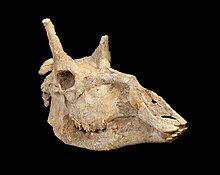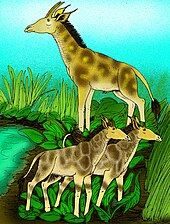| Samotherium Temporal range: Miocene to Pliocene, 11.608–2.588 Ma PreꞒ Ꞓ O S D C P T J K Pg N | |
|---|---|

| |
| Samotherium skull | |
| Scientific classification | |
| Domain: | Eukaryota |
| Kingdom: | Animalia |
| Phylum: | Chordata |
| Class: | Mammalia |
| Order: | Artiodactyla |
| Family: | Giraffidae |
| Genus: | †Samotherium Forsyth Major, 1888 |
| Species | |
| |
Samotherium ("beast of Samos") is an extinct genus of Giraffidae from the Miocene and Pliocene of Eurasia and Africa. Samotherium had two ossicones on its head, and long legs. The ossicones usually pointed upward, and were curved backwards, with males having larger, more curved ossicones, though in the Chinese species, S. sinense, the straight ossicones point laterally, not upwards. The genus is closely related to Shansitherium. Fossil evidence suggests that Samotherium had a rounded muzzle, which would suggest a grazing lifestyle and a habitat composed of grassland. One common predator of this animal was the Amphimachairodus.
Biologist Richard Ellis has proposed that the skull of Samotherium is portrayed on an ancient Greek vase as a monster that Heracles is fighting. However, other authors have argued that it is more likely to be the skull of a monitor lizard instead.
Description


A 2015 study found that Samotherium had a neck intermediate in length between the giraffe and the okapi, judging from examination of specimens of S. major from Greece.
References
- ^ "†Samotherium Forsyth Major 1888". Paleobiology Database. Fossilworks. Retrieved 21 February 2024.
- Walker, Cyril; Ward, David (2002). Fossils (2nd American ed.). Dorling Kindersley. p. 280. ISBN 0-7894-8984-8.
- Ellis, Richard (2004). No Turning Back: The Life and Death of Animal Species. New York: Harper Perennial. pp. 6. ISBN 0-06-055804-0.
- Monge-Nájera, Julián (2020-01-31). "Evaluation of the hypothesis of the Monster of Troy vase as the earliest artistic record of a vertebrate fossil". Uniciencia. 34 (1): 147–151. doi:10.15359/ru.34-1.9. ISSN 2215-3470.
- Danowitz, Melinda; Domalski, Rebecca; Solounias, Nikos (1 November 2015). "The cervical anatomy of Samotherium, an intermediate-necked giraffid". Royal Society Open Science. 2 (11): 150521. doi:10.1098/rsos.150521. PMC 4680625. PMID 26716010.
| Taxon identifiers | |
|---|---|
| Samotherium | |
 | This prehistoric even-toed ungulate-related article is a stub. You can help Misplaced Pages by expanding it. |